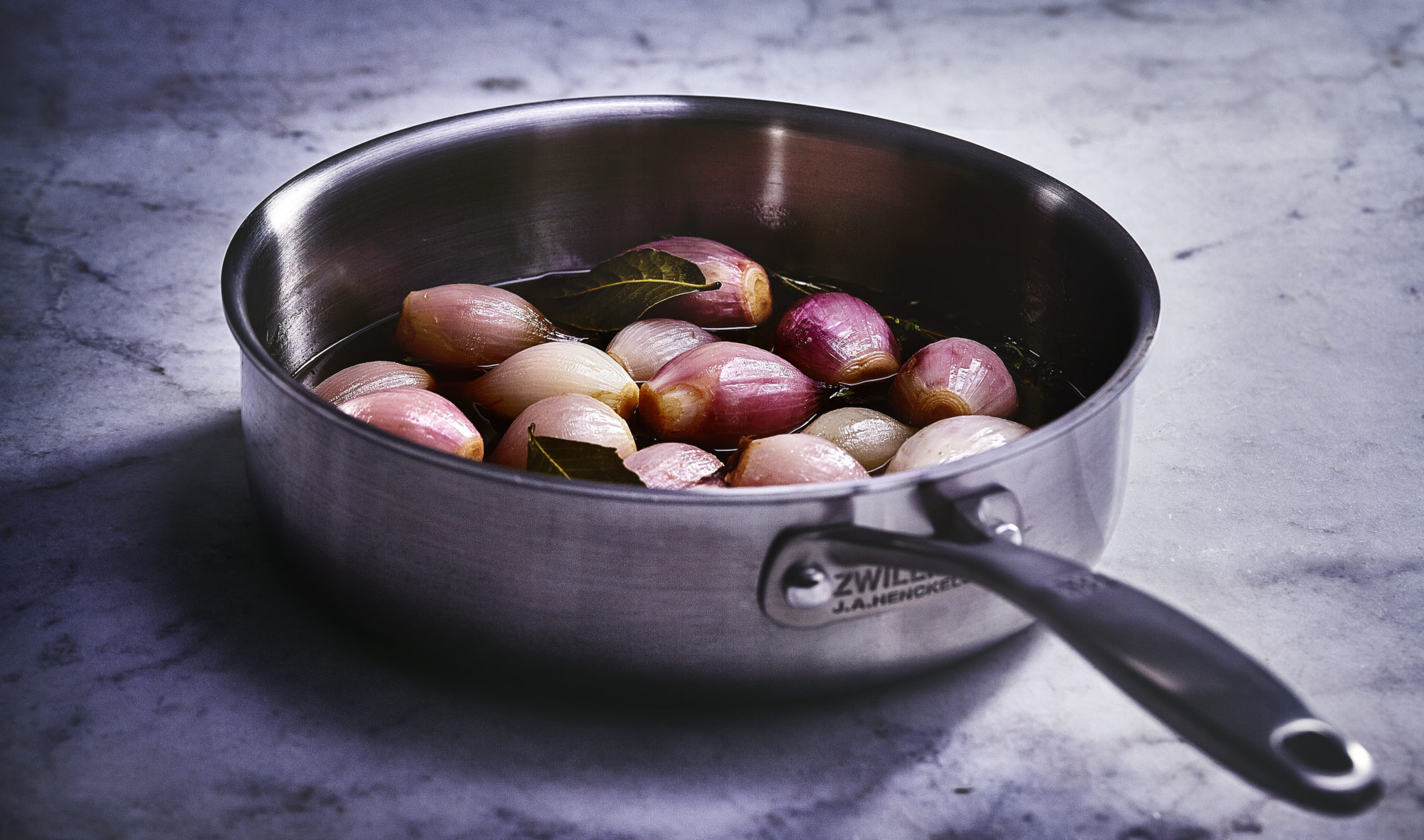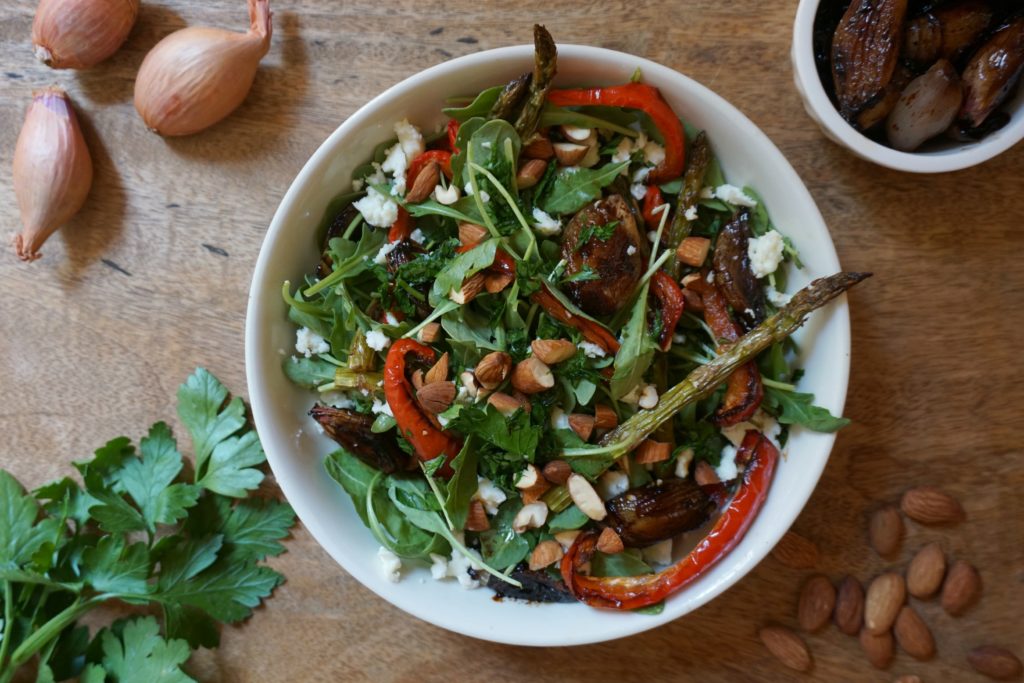
💥 Lowest price possible: on the Nutrition Coach Starter Package. Limited # left.

Shallots are a member of the Allium family and have the characteristic sulfurous pungency of its Allium cousins onion and garlic, and similarly, drive up sales of breath mints and gum. Like garlic, a shallot bulb will contain multiple large cloves, and like an onion, each clove will be composed of many layers. Shallots will typically range from light brown to a mid-purplish-red. Each teardrop-shaped clove is roughly the size of a thumb and is covered by a papery skin. In flavor, shallots taste very much like a milder and sweeter onion. Their flavor is highly pungent when raw, but mellows and sweetens when cooked. Shallots may be eaten raw or cooked, or if you are fancy and slightly old-timey, pickled.
Shallots are a member of the Allium family, a family of vegetables that significantly drives up breath mint and gum sales. Shallots have the characteristic sulfurous pungency of its Allium cousins onion and garlic, although they are milder and sweeter than both.
Like garlic, a shallot bulb will contain multiple large cloves, and like an onion, each clove will be composed of many layers. Shallots will typically range from light brown to a mid-purplish-red. Sometimes the cloves are long and other times they are short and squat.
Shallots originate from Central or Southwest Asia and are still hugely popular in the cuisines of these regions, as well as in Mediterranean cuisines, where they may be consumed raw, pickled, or fried.
A shallot bulb will usually contain two or three bulbs which may be fused together near the base of the bulb. Each teardrop-shaped clove is roughly the size of a thumb and is covered by a papery skin. This skin ranges from light brown to a mid-purplish-red, and flakes off easily, much like the skin of an onion.
Beneath the papery skin, shallots are smooth and firm and range from off-white to blushing purple. A cross-section of a shallot will reveal that, like an onion, it is composed of layers of flesh that form a ring pattern.
In flavor, shallots taste very much like a milder and sweeter onion. Their flavor is highly pungent when raw, but mellows and sweetens when cooked.
Three tablespoons of chopped raw shallot (about 30g) have 22 calories, 0.8g protein, 5g carbohydrates, 1g fiber, 2.4g sugar, and no appreciable amount of fat. In the amounts typically consumed, shallots are not a significant source of nutrition although, like other members of the Allium family, they are a relatively rare source of dietary sulfur.
Shallots are widely available at most grocery stores and fruit and vegetable markets year-round.
When purchasing, select shallots (which may be sold in bulbs or in loose cloves) that are firm, evenly colored, and have a protective coating of papery skin. Avoid specimens that have soft or moldy spots, or that appear damp.
Shallots can be stored just like onions and garlic. They are relatively shelf-stable and should stay fresh in a cool, dry storage area with good circulation for up to a month. They may also be kept in the fridge, but this actually shortens their lifespan to about two weeks.
Shallots may be eaten raw or cooked. If you are fancy and slightly old-timey, they may also be pickled.
In all cases, shallots are used more as a condiment than a complete dish.
To eat, peel off the papery skin and slice off any coarse bits (usually at the ends). Then, slice the shallot into thin rounds or mince. Add raw to salads, dressings, or marinades, or cook over medium heat with a bit of butter or olive oil until soft and fragrant, about 2 to 3 minutes. Add to cooked or raw vegetables, whole grains, meat, poultry, or fish.

Sweet caramelized shallots and roasted red peppers and asparagus meet savory feta cheese and crunchy almonds over a bed of fresh arugula - this is a salad that meets nearly all flavor notes and textures.
Prep Time: 20 minutes Cook Time: 90 minutes Yield: 4 servings
For the Caramelized Shallots
Preheat the oven to 400 degrees Fahrenheit.
In a large ovenproof pan over medium heat, add butter and allow to melt. Add shallots and sugar, and toss to coat. Cook for 7-10 minutes, tossing occasionally until the shallots start to brown. Then, add the vinegar, salt, and pepper, and toss to coat.
Place the pan in the oven, and roast for 15 to 25 minutes, until the shallots are tender. This time will vary according to the size of the shallots: Smaller shallots will tenderize faster; larger shallots will take longer. When they are done, allow to cool before serving.
For the Roasted Salad
First, roast the asparagus and red pepper: Preheat the oven to 400 degrees Fahrenheit. Toss sliced red pepper and asparagus in olive oil and sea salt and lay out on a large parchment lined baking tray, being careful not to crowd the veggies too much. Place in the oven for 15 minutes, remove and flip the veggies, then place back in the oven for another 13 minutes, until the veggies are soft with nice browning at the edges. Allow to cool slightly before serving.
Divide arugula between 4 bowls, then top with roasted veggies, caramelized shallots, crumbled feta cheese, chopped almonds, and parsley. Drizzle each bowl with a bit of olive oil and balsamic vinegar, and sprinkle with salt and pepper to taste. Serve immediately.
Precision Nutrition’s Encyclopedia of Food expands every single month as we highlight new foods and showcase beautiful food photography. If you’d like to stay up to date, simply click this link. From there, we’ll send you a FREE copy of our recipe book. We’ll also let you know when new and delicious foods are added to the site.
Shallots are a member of the Allium family and have the characteristic sulfurous pungency of its Allium cousins onion and garlic, and similarly, drive up sales of breath mints and gum. Like garlic, a shallot bulb will contain multiple large cloves, and like an onion, each clove will be composed of many layers. Shallots will typically range from light brown to a mid-purplish-red. Each teardrop-shaped clove is roughly the size of a thumb and is covered by a papery skin. In flavor, shallots taste very much like a milder and sweeter onion. Their flavor is highly pungent when raw, but mellows and sweetens when cooked. Shallots may be eaten raw or cooked, or if you are fancy and slightly old-timey, pickled.